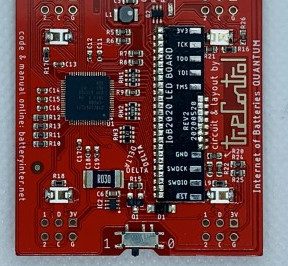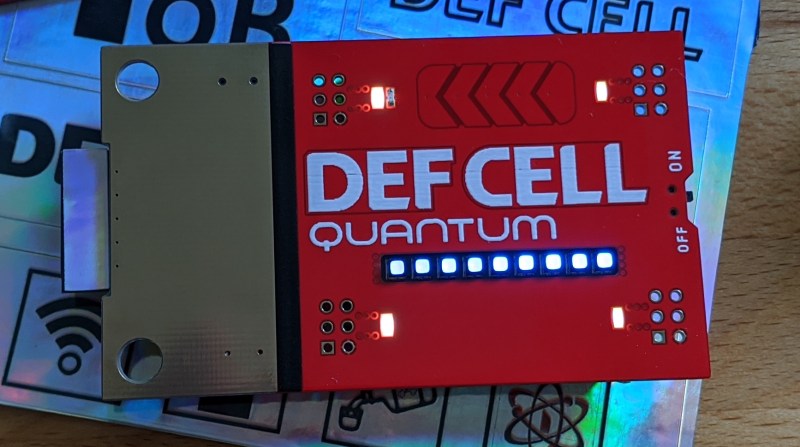Our friends in the Whiskey Pirates crew sent me the unofficial DEF CON badge they built this year. The Internet of Batteries QUANTUM provides power and connectivity to the all-important add-on badges of DC28. The front of the badge is absolutely gorgeous to the point I don’t really want to solder on my add-on headers and disrupt that aesthetic.
The gold-plated copper makes for a uniformed and reflective contrast to the red solder mask which occupies the majority of the front. Here we see the great attention to detail that [TrueControl] includes in his badges. The white stripe of silk screen separating the two colors is covered by some black detailing tape that looks much better than the white.
 The antenna of the ESP32 module poking out the underside of the gold cover end of the badge gets its own rectangle of the holographic sticker material, the same as the sheet of stickers that was included in the box. Both decals are small details that make a huge difference to your eye.
The antenna of the ESP32 module poking out the underside of the gold cover end of the badge gets its own rectangle of the holographic sticker material, the same as the sheet of stickers that was included in the box. Both decals are small details that make a huge difference to your eye.
The line of nine RGB LEDs have black bezels which goes along with the black stripe motif and underscores the typography of the badge name. These lights are hosted on a daughter board soldered to the underside of the badge with a slot for the LEDs to pass through. They are addressed in a 2×15 matrix that is scanned on the low side by the PSoC5 that drives the badge. This low-res image shows that daughter board before the lithium cell is placed.
User control is provided by a number of capacitive touch pads, one under the word DEF, another under the word CELL, and finally a row of five chevron shaped pads just above those words. The role of the badge is to provide power to add-ons so it makes sense that recharging is built in via a micro USB port.
One trademark design choice worth mentioning is the treatment of four white LEDs, one next to each of the SAO (“Shitty Add-on”) footprints. At first I thought these used cutouts in the board just like the RGB strip, but that isn’t the case. Instead, copper has been kept out of this area to expose the FR4 substrate. A normal surface-mount LED is hand soldered upside down so that it shines toward the board, using this keepout area in the PCB design as a diffuser. This is a trick that [TrueControl] used on last year’s Space Force badge, and while I personally found it quite tricky to get the hang of soldering them, it’s more cost effective than sourcing proper undermount LEDs.
As with many badgelife offerings, this is still a work in progress. The firmware that shipped with the badge is still in the “Hello World” phase. Development is ongoing, but many bold feature claims are made on the project’s GitHub page. The planned wireless features include a “Captive Arcade” which can be logged into via the WiFi access point provided by the ESP32. This makes it possible to to display analytics for power usage on each of the four SAO ports, and there’s even plans for a mesh network that incorporates socially interactive features like a chat room and private messages. On a battery?!
 Speaking of those SAO ports, there are both male and female headers provided. The idea is that the DEF CELL can be used to power not only an add-on, but a badge as well. When equipped with the
Speaking of those SAO ports, there are both male and female headers provided. The idea is that the DEF CELL can be used to power not only an add-on, but a badge as well. When equipped with the female shrouded pin header it effectively becomes an add-on for another badge, with the important distinction that this add-on has a Lithium battery and will “back-power” the host badge via the SAO port. Is that in the spec? No, that’s why this standard is known as “shitty”, there is inherent risk to connecting devices by different makers using these ports. But it might work without problems, it really depends on the host badge.
With both Bluetooth and WiFi available through the ESP32, and an I2C pin as part of each SAO footprint, it should be possible to use DEF CELL to show meaningful changes on add-on boards based on triggers from the Internet, or devices within wireless range of the badge. That’s a hack for the future, and certainly something we hope to see around your neck at next year’s DEF CON.





















Not available …
We sold ~50 running up and through DC28. There’s still some left for giveaways. If there really is enough interest we can build more for sale.
I was interested to see what actual battery they used – but followed the link to no avail..
The reason I was looking is that all the lithium batteries I try at about that size seem to be junk ie they work for a few months then don’t seem to hold charge.. So where does anyone get reasonable ones from?
More details at dc28.whiskeypirates.com
Is a 3.7v 900mAh lipo cell. Agreed that most are trash. Ours have been holding up well from last year. If these were heavily used then yes, it may not last, but these are meant as a fun con thing.
all the ones I’ve tried so far last about 100 cycles – and that’s without taking it right to the bottom of course. So if you cycle them once a day ie use them during the day, then charge overnight – they die after about three months…
Can you put up a link for the ones you use?
and I had the same problem with the 18650s until I found a supply in Aus that had genuine Panasonic ones – proven to be genuine by 1) amount of power I could put in and out 2) they have done hundreds of cycles and are still fine… With the 18650’s there are so many outright fakes, many that only have 1/4 of the state capacity, and many that don’t last past a few tens of cycles (or all of the above)…
I assume that is all true for the smaller ones like the ones in this project as well..
It’s a pity that HaD (apart from having a crap comment system) don’t have a forum where we can talk about specific parts etc etc..
“When equipped with the f̶e̶m̶a̶l̶e̶ shrouded pin header”
I understand you are trying to use language that is seen in many ways as an improvement on previous terms but this is confusing. I think the battery-side connector has sockets and the PCB connector has pins. As far as I can tell, JST and many other connectors are described based on the metal pin or socket, regardless of which side’s plastic housing makes its metal parts more or less exposed (so you could consider both sides to have “shrouds”). So I think you may have crossed out the wrong gender term here and rather than “shrouded” or “unshrouded” please could we use “pin”/”plug” and “socket”, as e.g. the kicad libraries have been using for quite some time, if we prefer not to use gender terms for our components. Very happy to be educated about connector naming convention as I’m sure there’s something that makes it easy to understand that I’ve never quite understood. Is there a simple way?
This strikethrough change was made because I incorrectly called it a female pin header when it’s actually a male pin header. The confusion is that the pins are shrouded, but if you look at the connectors in the image at the top of the article you see that three of them are pin sockets, the fourth is a shrouded pin header.
Got it, thanks. I mistakenly thought it was a reinforcement of the trend to move away from describing parts with words that some people dislike being used in that way. No need to “lock up your daughter boards!” at this point then ;-)
I am just surprised why standard mobile phone cells are not used. There is warranty and there is a fitting replacement.
*Which* “standard mobile phone cells”? Vendors change their cells between models; you expect multiple vendors to pick one as “standard”?
and they don’t stock them for very long, ie just when you need one they don’t have them any more..
They cost WAY too much and, if you see how we attach it, aren’t really feasbale for bare designs like this. That, and the cheap cells for the same size have less capacity and just as much failure (if not more) as the cells we already get.
Badge products aren’t typically used on battery charge daily – they need to last through con and usually a couple weeks after for dedicated people to play with, then usually get unused as they sit in a drawer or desk, or hang on a wall. An important part of part selection is to select for purpose and I think we’re doing fine with that.